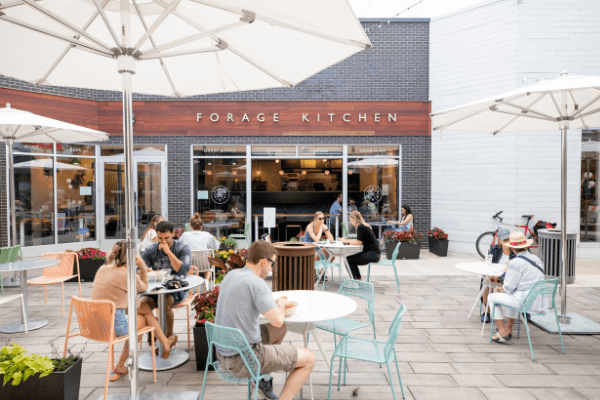Grocery stores are packed with products launched out of popular restaurants. Think Chi-Chi’s salsas, California Pizza Kitchen frozen pizzas or P.F. Chang’s frozen entrées. Similarly, plenty of independent restaurants package up and sell their signature items onsite, such as bottled sauces, growlers of beer or tubs of soup. Hey, if customers love coming in for certain foods or beverages, why not let them savor those flavors at home too?
But beyond delighting diners and strengthening customer loyalty, launching a CPG line can make good business sense for restauranteurs, as well as entrepreneurs who run food trucks, catering companies and other foodservice businesses. Even farmers, vintners, dairy operators and brewers may find opportunities to package and sell their products onsite, at local retail outlets, at farmers markets or all of the above.
Forage Kitchen, for example, has launched CPG and experienced myriad business benefits because of it. After establishing the healthy fast-casual eatery in Madison, Wisconsin, the company began brewing and canning kombucha for its three locations plus local cafés and coffee shops. Now Forage Kombucha is sold at some 800 retail outlets and growing. In the latest Edible-Alpha® podcast, co-founder Henry Aschauer discusses how launching a kombucha line has behooved the restaurant—and vice versa.
Here are six solid reasons why foodservice businesses can be excellent launchpads for CPG.
1. They facilitate real-time R&D
Few food and beverage entrepreneurs land on their final recipes immediately. Product research and development typically involves trial and error, test runs and tweaking, often based on feedback from samplings or surveys. While these simulated situations can produce valuable intel, it’s not always totally accurate or indicative of whether samplers would actually purchase the product.
Entrepreneurs who own restaurants, on the other hand, can demo and sample in a real-life setting, in real time. They can debut new flavors and formulations on the menu every week if they choose. Even better, they can collect feedback organically—even somewhat covertly—by tracking how well the products sell and gauging diners’ response to them.
2. They guarantee at least one customer
Another big perk is the CPG line will have one surefire customer: the restaurant. It may take time to get other outlets interested in carrying the product, but at least one business will purchase it to start, bringing in revenue to get the CPG off the ground.
3. They provide a test case for expanded distribution
Once Forage Kombucha proved to sell well at Forage Kitchen, Henry says it became easier to convince other restaurants, coffee shops and eventually grocery stores to carry the beverages. The products’ success at local grocery stores then provided a test case to take to retailers in Milwaukee and Minneapolis to broaden distribution further.
4. They help with cash flow
With CPG, the cash cycle is slow and the working capital requirements are high. A lot of money flows out for ingredients, packaging, prolonged distribution terms, etc., and that money takes a while to flow back. Foodservice operations generate cash flow much more quickly—as soon as customers pay their tab. Entrepreneurs can use some of this money to support the CPG business, especially when cash is tight.
5. They help build brand recognition and loyalty
When consumers know and love a restaurant, brewery, winery or farm, their awareness and affection is often transferred to its CPG business. It works in the other direction too: Someone discovers the CPG first, loves it and is inspired to give the foodservice spot a try.
6. They provide infrastructure for future product launches
After a foodservice business launches one line or product, it’s much easier to debut more. With the R&D process, production and distribution figured out, the infrastructure is there to keep expanding the company’s reach.
Henry Aschauer and his partners set out to establish a healthy fast-casual restaurant in Madison, Wisconsin, that they hoped could expand. Brewing and canning their own kombucha wasn’t originally in the cards. But recognizing the potential synergies and business benefits, they launched Forage Kombucha out of Forage Kitchen. Now both the restaurants and the beverage business are booming, and their many synergies have boosted efficiencies, cash flow and brand reach.
Listen to the Latest Episode
And now, our roundup of the best food and beverage finance news, events and resources from around the web…
Business Model Insights
- How to set the right expectations for the sales role (New Hope Network)
Lately an increasing number of startups are seeking help finding salespeople. Traditional sales ecosystems aren’t matching up to founder expectations, and founders want to avoid unhappy teams. - What brands need to know (and can do) to help climate justice and climate change (New Hope Network)
- Is your company ‘woke washing?’ (GreenBiz)
Raising Capital
- Should you entertain investment from your supplier or manufacturer? (New Hope Network)
Smart brands know they have to control their costs and tighten the supply chain, so partnering upstream with a supplier/supplier-manufacturer could help accomplish that. We see vertical integration happening at later stages, but what about early stage? - The right way to spend patient capital for food reform (GreenBiz)
- Good Food Makers connects startups with Barilla to address key challenges (New Hope Network)
CPG/National Brands
- Why food brands have a golden opportunity to be stewards of the environment (FoodNavigator-USA)
Emissions from food production are vastly underestimated, claims a new study. But its lead author is ultimately optimistic the industry can address its environmental problems. - Keto, a long-lasting trend? New keto product launches double in past year (FoodNavigator-USA)
- Beware of Brands That Love Queer People’s Dollars More Than Queer People (Eater)

Market Trends
- Continued fragmentation of the snacking market (Food & Beverage Insider)
Almost everyone snacks. But for snack brands, figuring out which consumers crave snacks at which times can be challenging. - Misconceptions About Gen Z Consumers Are Many (The Food Institute)
- Consumers Show Strong Interest in Knowing About Food Ingredients: “Clean” Is in, “Chemical-Sounding” Is Out (International Food Information Council)

Farming and AgTech
- It’s Some of America’s Richest Farmland. But What Is It Without Water? (The New York Times)
A California farmer decides it makes better business sense to sell his water than to grow rice. An almond farmer considers uprooting his trees to put up solar panels. Drought is transforming the state, with broad consequences for the food supply. - USDA to Strengthen Antitrust Laws for Meatpacking (Modern Farmer)
- Your Steak Is More Expensive, but Cattle Ranchers Are Missing Out (The New York Times)
 Deals/M&A
Deals/M&A
- GrubMarket Acquires Major Importer of South American Fruits (Progressive Grocer)
Food tech and e-commerce company GrubMarket continues its acquisition streak with Sierra Produce, one of the U.S.’s largest importers of South American fruits directly from growers. - Uber, DoorDash Moving Further into Grocery Delivery Space (The Spoon)
- Once Upon A Farm moves into frozen category with acquisition (Food Business News)

Industry Events
Virtual events:
- IFT FIRST: 7/19–7/21
- American Cheese Society Annual Conference: 7/28–7/30
- Direct 2021: The Virtual Conference for Your Farm Business: 8/3
- FFI Raising Equity Workshop: 9/21–9/23
- Natural Products Expo East Virtual Extension: 9/22–9/25
- Food Safety Consortium Virtual Conference Series: Thursdays 10/7–11/4
- Food & Nutrition Conference & Expo: 10/16–10/19
- American Food Manufacturing Summit: 11/16–11/18
In-person events:
- Acres U.S.A. Summer Intensive with Zimmer Ag: 7/19–7/20 in Lone Rock, WI
- Chicken Marketing Summit: 7/18–7/20 in Fernandina Beach, FL
- MOSES Organic Field Day: Organic Row Crops Plus Prairie Restoration: 7/22 in Madison, SD
- Rodale Institute Organic Field Day: 7/23 in Kutztown, PA
- MOSES Organic Field Day: Creative Land Access and No-Till Vegetable Research: 7/31 in Decorah, IA
- Soil Health Academy: Increasing Profitability Through Cropping System Management: 8/3–8/5 in Attica, IN
- Southern Family Farmers and Food Systems Conference: 8/8–8/10 in San Marcos, TX
- Dakotafest: 8/17–8/18 in Mitchell, SD
- MOSES Organic Field Day: Systems Approach to Organic Farming: 8/18 in Turtle Lake, WI
- MOSES Organic Field Day: Silvopasture for Livestock & Pollinators: 8/21 in Menomonie, WI
- SNAXPO21: 8/22–8/24 in Charlotte, NC
- Healthy Food Expo West: 8/22–8/24 in Anaheim, CA
- SupplySide East: 8/24–8/25 in Secaucus, NJ
- The NAFEM Show: 8/25–8/28 in Orlando, FL
- Farm Progress Show: 8/31–9/2 in Decatur, IL
- Food Automation and Manufacturing Conference and Expo: 9/12–9/15 in Miami, FL
- Organic Produce Summit: 9/15–9/16 in Monterey, CA




